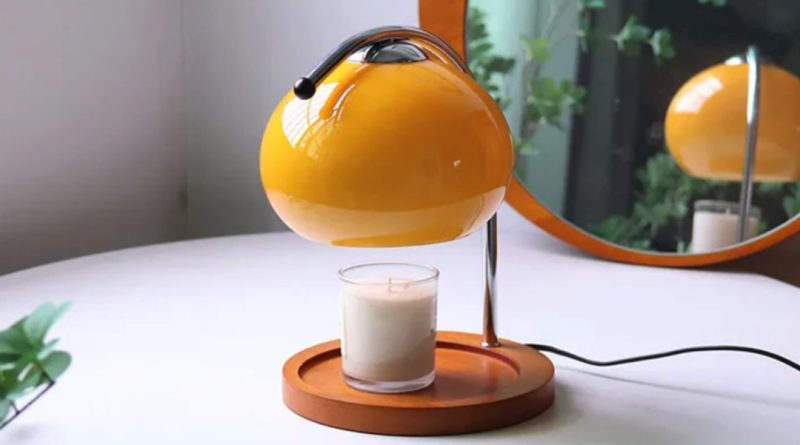Enhance Your Space with a Modern Bauhaus Glass Candle Table Lamp
Bauhaus design emerged in the early 20th century as a revolutionary movement that sought to unify art, craft, and technology. Founded by Walter Gropius in 1919 in Weimar, Germany, the Bauhaus school aimed to bridge the gap between fine arts and applied arts, emphasizing functionality and simplicity. The philosophy behind Bauhaus was rooted in the belief that design should be accessible to all, leading to the creation of objects that were not only aesthetically pleasing but also practical and affordable.
This approach marked a significant departure from the ornate styles of the past, favoring clean lines, geometric forms, and a minimalist aesthetic that continues to influence contemporary design. The Bauhaus movement was characterized by its interdisciplinary approach, where artists, architects, and designers collaborated to create innovative solutions for everyday living. This ethos is evident in the iconic works produced during this period, such as furniture designed by Marcel Breuer and lighting fixtures by Marianne Brandt.
The use of industrial materials like steel, glass, and concrete became hallmarks of Bauhaus design, reflecting the technological advancements of the time. As the movement evolved, it spread beyond Germany, influencing design schools and practices worldwide, ultimately laying the groundwork for modernist design principles that prioritize functionality and simplicity.
The Versatility of Glass in Home Decor
Glass has long been celebrated for its versatility in home decor, serving as a medium that can adapt to various styles and settings. Its transparent nature allows for an interplay of light and space, creating an illusion of openness and airiness in any room. From sleek glass tables to intricate glass sculptures, this material can enhance both contemporary and traditional interiors.
The reflective qualities of glass can also amplify natural light, making spaces feel larger and more inviting. This adaptability makes glass an essential element in achieving a cohesive design aesthetic. In addition to its aesthetic appeal, glass is also functional.
It can be molded into various shapes and sizes, allowing designers to create unique pieces that serve specific purposes. For instance, glass shelves can provide a minimalist storage solution while showcasing decorative items without overwhelming the space. Similarly, glass lighting fixtures can add a touch of elegance while ensuring that light is diffused evenly throughout a room.
The ability to combine glass with other materials—such as wood or metal—further enhances its versatility, enabling homeowners to curate personalized environments that reflect their individual tastes.
Benefits of Using a Table Lamp for Interior Design
Table lamps Woyik are more than just sources of light; they are integral components of interior design that can significantly influence the ambiance of a space. One of the primary benefits of incorporating table lamps into home decor is their ability to provide layered lighting. Unlike overhead fixtures that cast a uniform glow, table lamps can create pockets of light that enhance the mood and functionality of a room.
By strategically placing lamps in various areas, homeowners can achieve a warm and inviting atmosphere that encourages relaxation or productivity, depending on the setting. Moreover, table lamps serve as decorative accents that can complement or contrast with existing decor elements. With a wide range of styles, colors, and materials available, selecting the right table lamp can elevate the overall aesthetic of a room.
For example, a sleek modern lamp can add a contemporary touch to a minimalist space, while an ornate vintage lamp can serve as a statement piece in a more traditional setting. Additionally, table lamps can be easily moved and repositioned, allowing for flexibility in design as needs and preferences change over time.
How to Incorporate Bauhaus Style into Your Home
Incorporating Bauhaus style into your home involves embracing its core principles of simplicity, functionality, and harmony between form and function. One effective way to achieve this is by selecting furniture pieces that embody the Bauhaus ethos. Look for items with clean lines and geometric shapes made from industrial materials such as metal and glass.
For instance, a Breuer-style cantilever chair or a sleek glass coffee table can serve as focal points that reflect the Bauhaus aesthetic while providing practical seating and surface solutions. Color palettes in Bauhaus design tend to be muted with occasional bold accents. To create an authentic Bauhaus-inspired space, consider using neutral tones like whites, grays, and blacks as your base while introducing pops of primary colors—red, blue, and yellow—through accessories or artwork.
Additionally, incorporating abstract art or geometric patterns can further enhance the visual interest in your home while staying true to the Bauhaus philosophy. Lighting also plays a crucial role; opt for fixtures that showcase industrial materials and minimalist designs to complete the look.
The Impact of Lighting on Mood and Atmosphere
Lighting is one of the most powerful tools in interior design, capable of transforming the mood and atmosphere of any space. The type of lighting used—whether natural or artificial—can evoke different feelings and responses from those who inhabit the space. For instance, soft ambient lighting creates a cozy and intimate environment ideal for relaxation or social gatherings.
In contrast, bright task lighting is essential for workspaces where focus and concentration are paramount. Understanding how different lighting affects mood is crucial for creating spaces that cater to specific activities or emotions. Moreover, the placement of lighting fixtures can significantly influence how a room feels.
Layering different types of lighting—such as ambient, task, and accent—can create depth and dimension within a space. For example, combining overhead lights with strategically placed table lamps can provide both general illumination and targeted light where needed. Additionally, using dimmers allows for greater control over brightness levels, enabling homeowners to adjust the lighting according to their needs or preferences at any given moment.
This flexibility not only enhances functionality but also contributes to an overall sense of well-being within the home.
The Functionality of a Glass Candle Table Lamp
A glass candle table lamp combines aesthetic appeal with practical functionality, making it an excellent addition to any interior design scheme. These lamps often feature elegant designs that showcase the beauty of glass while providing soft illumination through candlelight. The use of glass allows for intricate designs that can range from minimalist to ornate, catering to various tastes and styles.
When lit, these lamps create a warm glow that enhances the ambiance of any room, making them perfect for intimate settings such as dining areas or bedrooms. In addition to their decorative qualities, glass candle table lamps offer versatility in terms of placement and use. They can be positioned on side tables, mantels, or even as centerpieces on dining tables to create a focal point during gatherings.
Many designs also allow for easy replacement of candles or incorporation of LED options for those who prefer low-maintenance solutions. This adaptability makes them suitable for various occasions—from everyday use to special events—while adding an element of sophistication to any decor.
Tips for Choosing the Right Table Lamp for Your Space
Selecting the right table lamp involves considering several factors that align with both functional needs and aesthetic preferences. First and foremost is the scale of the lamp in relation to the surrounding furniture and space. A lamp that is too large can overwhelm a small table or room, while one that is too small may get lost among larger furnishings.
It’s essential to strike a balance where the lamp complements its environment without dominating it. Another critical aspect is the style of the lamp itself. When choosing a table lamp, consider how it fits within your overall design theme.
For instance, if your home features mid-century modern decor, look for lamps with clean lines and organic shapes typical of that era. Additionally, pay attention to the type of light bulb used; warmer bulbs create a cozy atmosphere while cooler bulbs are better suited for task-oriented spaces like offices or kitchens. Finally, don’t overlook practical considerations such as ease of access to switches or dimming capabilities that enhance usability.
Where to Find Modern Bauhaus Glass Candle Table Lamps
Finding modern Bauhaus glass candle table lamps requires exploring various sources that specialize in contemporary design or vintage pieces inspired by this iconic movement. Online retailers such as Wayfair or West Elm often carry collections that feature Bauhaus-inspired designs alongside other modern aesthetics. These platforms provide extensive options ranging from affordable reproductions to high-end designer pieces.
For those seeking authentic vintage items or unique finds, visiting local antique shops or flea markets can yield surprising results. Many dealers specialize in mid-century modern furniture and decor, including Bauhaus-inspired lighting fixtures. Additionally, websites like Etsy offer handmade or vintage items from independent sellers who may have curated collections reflecting Bauhaus principles.
By exploring these diverse avenues, homeowners can discover stunning glass candle table lamps that not only illuminate their spaces but also embody the timeless elegance of Bauhaus design.


